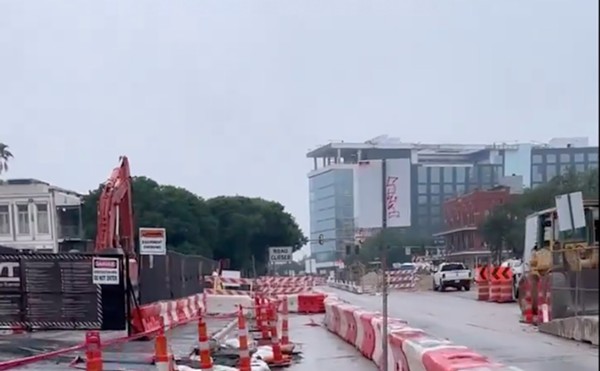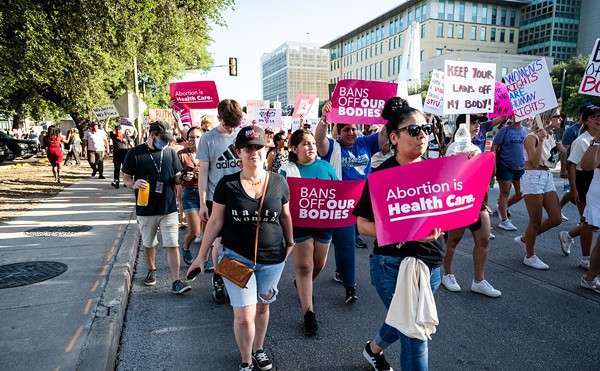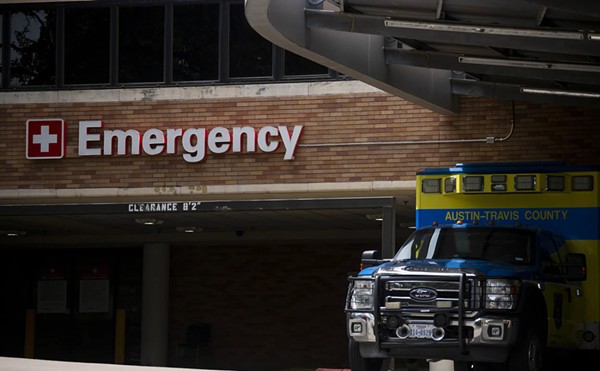This land is our land
Is it telling that “charrette,” that touchy-feely design process beloved of progressive urban planners, and “charade” both derive from the French charrá — to chat or chatter? (K, maybe not. Queque’s not a linguist. But they could.) In any event, the words were bumping into one another in Queque’s noggin after we learned of a December public meeting to air the proposed fate of Healy-Murphy Park, a neglected plot of greensward sold to the city in 1978 for 10 bucks and named in honor of Margaret Mary Healy-Murphy, a motivated Irish transplant deified for her service to the East Side’s less-advantaged. You’d recognize it as you drive up I-37 as a lone spot of eastward vista not occupied by the Alamodome or a beige limited-service hotel.
Despite outright fury from a formidable coalition that includes the Dignowity Hill Neighborhood Association and the Salvation Army (seller of that plot three decades ago for the express purpose of making a park), District 2 Councilwoman Sheila McNeil has steamrolled her desire to sell the park to the highest bidder (perhaps the hotelier she declined to name at a meeting with the aggrieved parties in October) into a Request for Proposals (read: offers), that’s being crafted by City staff even as you read.
To velvet the glove, and meet parkland regulations, McNeil’s office has pledged to donate the proceeds — recent valuation $800,000, according to Parks & Rec — to the Hays Street Bridge cause, so the City can turn adjacent publicly owned land into a park. The councilwoman has also decided to forego a battle with the Conservation Society over the fate of the on-site historic Dullnig House (currently home to a CentroMed clinic) by specifying that any purchaser must preserve the structure.
Not to look a gift horse in the mouth, says Hays Street Bridge spearhead and Dignowity NA member Nettie Hinton, but, “The council member did not come to the Hays Street restoration group,” with her plan before she announced it. Or for that matter, to the neighborhood association or the adjacent Healy-Murphy school.
Hinton acknowledges that Healy-Murphy park, which McNeil’s office describes as “underutilized,” is currently a homely crime magnet, but notes that the City has put little to no resources into improving it. “If anything, it’s overutilized at inappropriate times,” said Hinton. “So there needs to be an adaptive reuse if we are successful in keeping it from being sold.” Community gardens and youth-program facilities, e.g.
Jose Macias Jr., director of development for the Salvation Army, which operates a residential facility next to the park, says his organization has an interest in addressing the crime, which can thwart the best intentions of clients in their rehabilitation program, but they don’t want to see the park sold to a private entity, either. The threat from the Councilwoman’s office has galvanized the neighborhood’s stakeholders, he told the Queque, and he sees a lot of potential, “a lot of community interest in making that a better park.”
The newly born Healy-Murphy Park coalition plans to block-walk ahead of the proposed December meeting, which will be a crucial event. The RFP will have been drafted and reviewed already by members of the Parks and Rec Board, and following that charade — charrette, rather — Parks and Rec Director Xavier Urrutia expects the RFP, which remains open for 30 days, to be issued by mid-December. Opponents of the sale fear that will be the death knell for Healy-Murphy’s acre, despite the City’s reassurance that it’s “just starting a process” it can stop at any time.
“The City Council will get `the bid` and say, we want it,” fears Macias. So, the Healy-Murhpy coalition’s been reaching out to area organizations that might work with them to save the park, including the Green Spaces Alliance — whose board, coincidentally, includes Linda Hardberger, wife of our usually pro-parks Mayor, who has till this point remained neutral.
Third verse, same as the first
Healy-Murphy’s would-be saviors might find the ongoing tug-of-war over the Avenue A/B river improvements instructive, if not inspirational.
“We’ve told you time and again what we want,” unhappy District 8 resident Georgina Schwartz told the Park Segment Subcommittee at Monday night’s public meeting. “And we want you to leave Avenue A alone.”
The occasion of the contentious confab: Collecting public comments (again) on proposed hike and bike trails connecting downtown to Brackenridge Park, part of the San Antonio River Improvements Project funded by last spring’s venue-tax extension. Or, if you prefer, an exercise in futility: No matter how many public hearings the City convenes, no matter how many times it presents the map with two paths winding north from Josephine to Mulberry, it seems unlikely that advocates for running the hiking/jogging trail along Highway 281, Craig Avenue, and bucolic little Avenue A will ever outnumber those opposed. These are not just any opposed, mind you. The River Road neighborhood, which would be directly impacted by the Avenue A route, is an intellectual and creative A-list that includes artist Marilyn Lanfear, New Age author Walter Starcke, and clothing designer Kathleen Sommers, to name just a handful of recognizable nay votes.
Like many of the other speakers, Lanfear wondered what was wrong with using the Avenue B route, along the eastern edge of Brackenridge Golf Course for foot and wheeled traffic, especially if some funds were dedicated to improving the unsightly cement sluice with the unlikely poetic name (the Catalpa-Pershing drainage ditch) that it parallels. It’s not like the downtown River Walk follows the course of the natural river, observes Sommers.
Resident Bill Sibley reminded the assembled crowd of 60-odd folk that the City projects annual transits of 150,000 on the route, a number not lost on Sommers, who’s lived on Craig Street for 23 years. Her objections are fourfold, she says: The Avenue A route will disturb the neighborhood, disturb the birds that stopover and nest along the river, make hikers and runners breathe commuter fumes as they exercise beside the freeway, and cost more taxpayer money than developing a single hike and bike trail along Avenue B.
A few idealistic types (who, perhaps, haven’t been paying close attention lo these long months of debate) even fingered the elephant in the room. Why can’t the route follow the river straight up the middle, between the front and back nines of the golf course? asked one woman, who either didn’t know the City bargained away that option when it handed the greens fees and keys over to the Municipal Golf Association-SA, or thought, what the hell, if you’re going to make us go through the charrette — charade, rather — of yet another public hearing on this issue when you know damn well you’re building the Avenue A route, I’m going to call you out.
That last bit of editorializing relays the sentiment of many River Road residents and birders who’ve been involved in this process from the beginning. They say Howard Peak, former mayor and progenitor of the 13-mile linear park that will run from the river’s headwaters just north of Hildebrand to Mission Espada, is set on Avenue A come hell and high water (at which point, no, you wouldn’t be able to use the low-water crossing from River Road to Avenue A. Turn around, don’t drown).
“For over a year and a half now you have not budged one inch in your determination to have the Trail exactly where you want it,” Sibley wrote in a recent email to Peak. We’ll know whether that’s still true after Monday’s meeting when the architects finish the feasibility study — due to the Park Segment Subcommittee by November 24. The subcommittee will have a final meeting in early December. Watch Curblog for updates, and if somehow you’ve missed this whole flap, read, “It’s for the birds.” `April 30, 2008.`
The wall to nowhere
Sixty-something days. For some, they can’t pass fast enough. By “some” we mean those losing land, liberty, and fraternity on La Frontera.
In honor of the fall of the Berlin Wall on a rowdy November day almost 20 years ago, Queque joined members of the Southwest Workers Union outside the U.S. Federal Building last week to raise a stink over the newest Berlin variant now under construction in the lingering hours of Bush twilight. As it turned out, Homeland Security officials announced that same day they were suspending construction of 14 miles in Hidalgo and Starr counties over flooding concerns.
This does not affect other portions of Texas borderland, like nearby Cameron County, or El Paso County — where seven-day-a-week schedules have crews erecting miles of steel curtain in the desert even as Homeland Security Secretary Michael Chertoff dusts off his résumé.
As much as we’d like to think the Valley decision was a portrait of political acquiescence, wall construction could conceivably live on past Bush. Legal challenges have, to date, been swept aside by the U.S. Supreme Court. Obama was a “yea” vote on the 2006 Secure Fence Act that demanded the wall to begin with. And until there is sweeping immigration reform, the wall will likely continue to be the Interior’s fall-back plan.
However, readers and activists are reminding Queque of statements Obama made in the Valley months ago, when the Dem Primary was still running hot: That he would “reverse that policy.” His appointment of University of Texas at Brownsville President Juliet V. Garcia to his transition team has a promising glint to it, considering Garcia was the rock-’n’-roller who challenged Homeland over plans to put the Wall through her campus.
Arizona Congressman Raul Grijalva is said to be busily rewriting his failed legislation for a new Congress to undo provisions of the Real ID Act that allowed Chertoff so-called “mega-waiver” authority to override dozens of federal laws so he could erect the wall over environmental and other objections. Activists are planning two major gatherings: one this weekend at Friendship Park beneath San Diego, another in El Paso early next month, to plan their legislative assault to finally lay waste to the Border Wall.
What to do in the meantime, as our faltering economy continues to bleed $3 million-plus into each steel mile? •

















